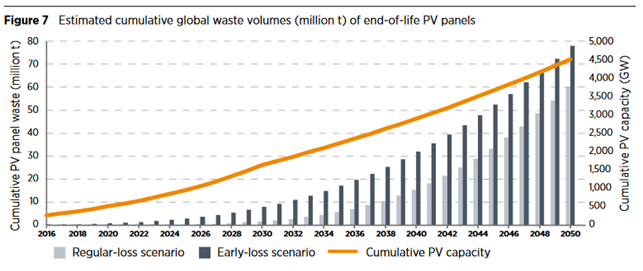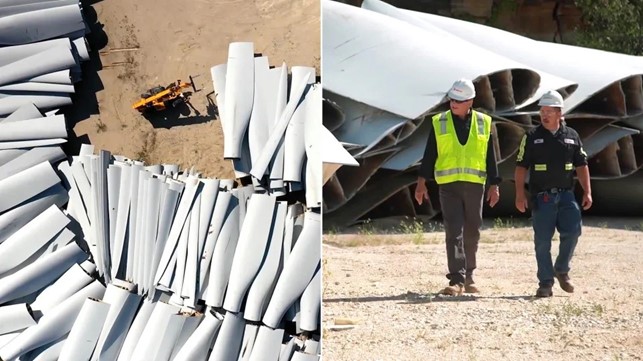Challenges of Recycling Solar Panels and Windmill Blades
With the world’s growing concern about climate change and the need to shift towards renewable energy sources, solar panels, and windmills have become increasingly popular for generating electricity (World Economic Forum, 2022). These technologies offer great promise in reducing greenhouse gas emissions and mitigating the effects of climate change. However, as with any technology, there are challenges to be addressed. One significant challenge is recycling solar panels and windmill blades, which present unique and complex issues that must be tackled to minimize their environmental impact (e.g., Wheeler, 2021; Korniejenko et al., 2021).
Solar panels, made from materials like silicon, glass, and metal, have an average lifespan of 25 to 30 years (e.g., Hurdle, 2023, Sharma and Powell, 2022). While incredibly durable and reliable for producing electricity, they also have a finite lifespan and will eventually need to be replaced. Similarly, windmill blades, typically made from fiberglass or carbon fiber composites, have a lifespan of around 20 to 25 years (Jacoby, 2022). When these solar panels (see figure below) and windmill blades reach the end of their life cycle, they pose challenges for recycling due to their construction, composition, and size.

One of the main challenges in recycling solar panels is the complexity of their composition. Solar panels consist of multiple layers of different materials, including glass, plastic, metal, and silicon cells, which are all bonded together. These layers must be separated to extract valuable recycling materials, which can be time-consuming and energy-intensive. Additionally, some materials used in solar panels, such as thin films of cadmium telluride or copper indium gallium selenide, are considered hazardous and require proper handling and disposal to avoid environmental contamination. (Sica et al., 2018)
Another challenge is the size and weight of solar panels and windmill blades. Solar panels can be large and heavy, making transportation and handling for recycling purposes challenging. Windmill blades, on the other hand, can reach lengths of up to 75 meters and weigh several tons, making their disposal or recycling even more complex and costly (Cherrington et al., 2012). Finding appropriate facilities capable of handling such large and heavy items is a significant challenge, especially in remote areas where renewable energy projects are often located.

he recycling of windmill blades, in particular, presents additional challenges. Windmill blades are typically made from fiberglass or carbon fiber composites, which are lightweight and durable but challenging to recycle. These materials are difficult to break down and separate, and current recycling technologies must be improved in their ability to process them effectively. As a result, windmill blades often end up in landfills or are incinerated, contributing to the accumulation of waste and emissions. (Mishnaevsky, 2021)
Furthermore, the rapid growth of the renewable energy industry has led to increased decommissioned solar panels and windmill blades. This has created a potential waste management problem, as many of these end-of-life panels and blades are not being appropriately recycled or are not being recycled at all (Seo et al., 2021). Improper disposal can lead to environmental pollution, habitat destruction, and health risks for local communities.
Addressing these challenges requires innovation and collaboration among various stakeholders, including governments, industry, researchers, and waste management facilities. Here are some potential solutions to tackle the challenges related to the recycling of solar panels and windmill blades:
- Research and development: Continued research and development in recycling technologies specifically tailored for solar panels and windmill blades could lead to more effective and efficient recycling processes. This may include advancements in material separation techniques, such as using solvents or heat to separate different layers of solar panels (Chowdhury et al., 2020) or developing new methods to break down and recycle composite materials from windmill blades.
- Extended Producer Responsibility (EPR): Implementing EPR policies, where manufacturers are responsible for the end-of-life management of their products, could incentivize the development of more recyclable solar panels and windmill blades.
Written by Nicolas Le Grand, Turku University of Applied Sciences
References:
Cherrington R., Goodship V., Meredith J., Wood B.M., Coles S. R., Vuillaume A., Feito-Boirac A., Spee F., Kirwan K., 2012, Another challenge is the size and weight of solar panels and windmill blades. Solar panels can be large and heavy, making transportation and handling for recycling purposes challenging. Energy Policy, Volume 47.
Chowdhury Shahariar, Rahman Sajedur Kazi, Chowdury Tanjia, Nuthammachot Narissara, Techato Kuaanan, Akhtaruzzaman MD., Tiong Kiong Sieh, Sopian Kamaruzzaman, Amin Nowshad, An overview of solar photovoltaic panels’ end-of-life material recycling, Energy Strategy Review, Volume 27.
Hurdle Jon, 2023, As Millions of Solar Panels Age Out, Recyclers Hope to Cash In, Published by Yale School of the Environment.
Jacoby Mitch, 2022, How can companies recycle wind turbine blades ?, Chemical and Engineering news, Volume 100, issue 27
Korniejenko Kinga, Kozub Barbara, Bak Agnieszka, Balamurugan Ponnanbalam, Uthayakumar Marimuthu, Furtos Gabriel, 2021, Tackling the Circular Economy Challenges—Composites Recycling: Used Tyres, Wind Turbine Blades, and Solar Panels, Journal of Composites Sciences, Volume 5, Issue 9.
Mishnaevsky Leon, 2021, Sustainable End-of-Life Management of Wind Turbine Blades: Overview of Current and Coming Solutions, Materials, Volume 14, Issue 5.
Seo Bora, Kim Youing Jae, Chung Jaeshik, 2021, Overview of global status and challenges for end-of-life crystalline silicon photovoltaic panels: A focus on environmental impacts, Waste Management, Volume 128
Sica Daniela, Malandrino Ornella, Supino Stefania, Testa Mario, Maria Claudia Lucchetti, 2018, Management of end-of-life photovoltaic panels as a step towards a circular economy, Renewable and Sustainanble Energy Reviews, Volume 82, Part 3.
Shawa and Powell, 2022, This is how solar panel recycling can be scaled up now, World Economic Forum.
Weckend Stephanie, Wade Andreas, Heath Garvin, 2016, End-of-life management; solar photovoltaic panels, IRENA and IEA-PVPS.
Wheeler Andrew, 2021, The Need to Examine the Life Cycles of All Energy Sources: A Closer Look at Renewable-Energy Disposal, No. 3653, Institute for economic freedom, the Heritage Foundation.
World Economic Forum, 2022, Wind and Solar generated 10% of global energy in 2021-a world first. https://www.weforum.org/agenda/2022/04/wind-solar-electricity-global-energy/


